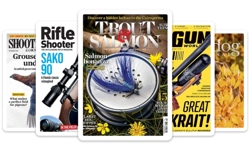Niche and specialist (N&S) distribution is the sale of magazines through non-traditional news retail outlets. It is not new – yachting magazines have been sold through chandleries, wine mags through off-licenses and riding mags through saddleries for as long as anyone can remember. What is new is the fact that the volumes of copies going through this channel has increased dramatically over the last ten years and that more publishers are waking up to the potential provided by N&S.
Dave Sholl, managing director of specialist N&S distributor Worldwide Magazine Distribution (WWMD) dates the accelerated growth to the mid 90s when the launch of men’s lifestyle titles (FHM, Loaded et al) and console titles created a surge in demand for distribution in non traditional outlets. One of the early movers was the Electronic Boutique / Games Group, a retailer specialising in gaming and console products. It wanted to sell FHM but was rebuffed by the wholesalers since its outlets did not fit neatly into the existing supply chain. Wholesalers are set up for news provision – the nightly miracle of servicing the 55,000 odd news retailers before 9am every morning. Weekly, single title, deliveries after 9am did not fit their model so they turned the business down. FHM then approached WWMD who were able to help. IPC, publishers of Loaded, naturally were also interested – but they were also turned down by the wholesalers. All this meant steady growth for WWMD and a feeling of growing unease within the wholesalers – a sense that they were missing out on a flourishing route to market. So, partly to protect their position, the major wholesalers clubbed together to form a company called Focus Magazine Distribution (FMD) in 1998 to compete direct with companies like WWMD in providing N&S distribution. To cut a long story short FMD then purchased their bigger and more established rival WWMD a year later. The new company retained the name WWMD but was now a joint venture owned by the wholesalers.
Potential of market
There are approx 250,000 non news retail outlets who could be selling your magazine. Throw into the mix the fact that WWMD, one of the leading players in this field currently services 8,500 retailers (a drop in the retail ocean) and you can see that there is a massive number of retailers who do not currently sell magazines. In his recent study into specialist magazine publishers, Jim Bilton (InCirculation, issue 9) estimated that copy sales through specialist retailers represented just 8% of circulation revenue.
According to Dave, "every retailer has the potential to sell magazines. Each will have its own customer profile and there will be a magazine segment to match." Decanter will sell at Oddbins but not at your local riding school, and vice a versa for Your Horse. There will be those retailers that provide a direct and obvious customer profile fit (eg cycling titles / cycle shops). Then there is a larger secondary group where the match is not quite so obvious but where certain customer characteristics closely match those of your readers (eg. celebrity, real life titles / shops popular with women). Once you’ve identified your target outlets then you need to market your title to them – buy a list, create an offer, win the order, fulfil the offer. Not rocket science, just good old direct marketing basics.
Fulfilment
As with any circulation activity, the flip side to marketing is fulfilment. Here there are two options – you can either do-it-yourself or you can get a company like WWMD to do it for you. A lot of the nervousness about the N&S route to market has its origins in fulfilment horror stories, usually associated with brave, if misguided, attempts at DIY.
There are a number of good reasons against fulfilling your N&S orders in-house. Packing boxes is not a good use of your marketing manager’s time and sufficient quantities of brown paper and desk space are hard to come by. Because it represents the low point in your working week it gets put off so your N&S customers get their copies late. The chances are high that your payment collection procedures are not up to it, so you don’t get paid and your returns management / delivery documentation is ropy so you can’t even claim these copies on your ABC. Last but not least, unless you are part of a bigger group, you are unlikely to get any preferential rates from your courier. The problem with these valiant in-house operations is that they are too often doomed to failure – thereby discrediting the whole N&S route to market. A number of new accounts won recently by WWMD are from publishers returning to N&S after a long absence caused by one bad experience or another.
The alternative? Get a company like WWMD to do it for you! WWMD offers two types of service – one you might call "full service" (including distribution, payment collection and returns management) and the other - "distribution only" (more of a courier service). An example of the former is the supplying of Wine International into Majestic Wine Cellars and an example of the latter is OK into British Home Stores.
The business model
Perhaps another reason for the under performance of the N&S sector is that many publishers either are not comfortable with or are unsure of the precise business model. We all know our newstrade and subs models and the margins within each. With N&S it’s a movable feast. The costs are less fixed. Each N&S distribution run has to be costed independently and will depend on logistical issues. The margins are tighter and, as Dave points out, N&S is not the cheapest form of circulation. Why then should you consider N&S as opposed to sinking all your resources into either newstrade or subs? As far as newstrade is concerned, the challenges are well documented and most publishers concede that they need to end their over-reliance on this route to market. As for subs – yes, publishers should continue to explore the subs avenue, but this should not be a question of "either / or". N&S distribution has some distinctive and unique advantages:
* Targeted exposure
By getting your title into a reputable and appropriate outlet, you are effectively winning the subliminal endorsement of that shop in your title. Their customers will see your title in an environment they trust and will identify it with their interest or outlook.
* Increased auditable circulation
If yours is an ABC audited title, then every copy counts. These are marketing copies that can contribute to your headline ABC figure.
* Deeper relationship with your advertising clients
As Dave Sholl points out, any advertiser has the potential to sell copies of your magazine, so why not build into your rate card 10 "free" copies of the title. These do not need to be for resale, but it is the start of a relationship that could develop into a sales opportunity. You could even list, as Wine International does, the names of outlets where the title is on sale – a footfall driver bound to be appreciated by your advertisers.
* Subscription opportunities
All single copy sales are potential future subscriptions – but perhaps more so with those sold through N&S. Depending on the nature of the outlet, it is quite likely that the average customer will not be a frequent visitor. This means that if they like your magazine, yet know that they are unlikely to be in the shop again for a few months, then subscription is a very obvious choice.
N&S might not be the cheapest form of circulation, but it is, arguably, a very cost effective form of marketing. As such, perhaps it should be seen more as a marketing cost than a circulation one.
Realising the potential
There are tens of thousands of retail counters up and down the country untouched by magazines. This fact alone should make any publisher restless. There are two ways of making inroads. The first way is to dust down your direct marketing skills and get creative. Identify the retail outlets who might be interested in stocking your magazine and market to them. Set aside budget for this process and resource accordingly. Decanter employs a member of staff to handle all N&S marketing. They do the marketing, harvest the orders and then pass them onto WWMD to be fulfilled. The second way is to be the beneficiary of someone else’s hard work! WWMD, although primarily a fulfilment company, does however work to increase the size of the N&S sector. If they see a large enough opportunity then they will put together magazine packages for retail groups. A good example is Halfords. Two years ago, they sold no magazines and now they sell twenty titles. WWMD’s director of sales, Mark Sheridan, designed a package for Halfords containing a full service offer and introducing a full list of potential titles. Halfords liked the idea and selected the titles they thought would appeal most. Mark then approached the publishers - most jumped at the idea and the rest is history.
Talking with Dave and Mark, I sense an impatience to make big inroads into the UK retail universe. As a logistics company, albeit one with a magazine heritage, they want to maximise their volumes. They are talking to companies such as Hobbycraft and Wyevale Garden Centres – indeed they are currently running a merchandised offer for the later category of outlets – but the key to future growth is publisher involvement. Publishers know their markets and are best placed to make the first move. Once a demand has been established then companies like WWMD can then go about fulfilling it. Interested but not sure? Why not call Mark Sheridan on 0121 788 3112 to discuss it.
FEATURE
Niche & specialist
Whereas the traditional newstrade is full to bursting, the N&S route has huge growth potential. Many publishers have shied away from it in the past, unsure of the precise business model and put off by its perceived complexities. James Evelegh talks to WWMD’s Dave Sholl and Mark Sheridan about why publishers should look afresh at N&S.










